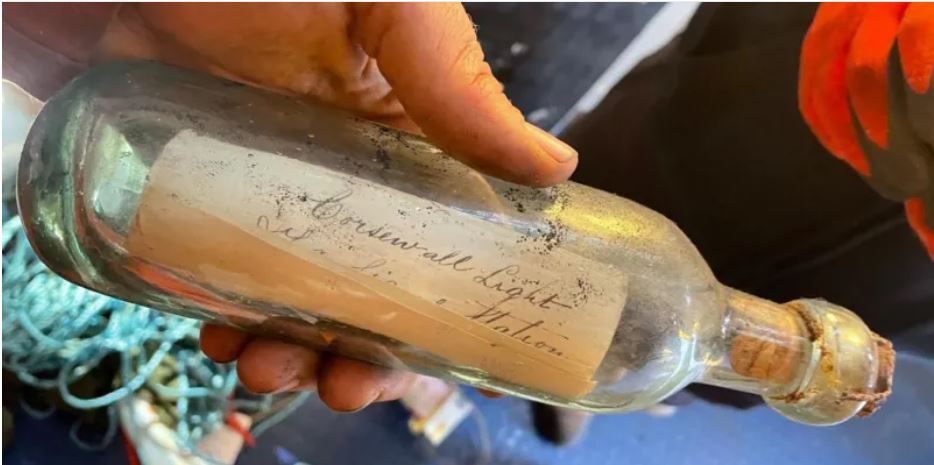
Engineers have found a bottle with a 132-year-old message deep inside the walls of a lighthouse in the south of Scotland.
The bottle was found inside the Corsewall Lighthouse at the most northerly point of the Rhins of Galloway.
The "once in a lifetime" find is understood to be the first message in a bottle ever discovered in a lighthouse in Scotland.
Written using quill and ink, the letter dated 4 September 1892 reveals the names of three engineers who installed a new type of light in the 100ft (30m) tower.
It also has the names of the lighthouse's three keepers.
The 8in (20cm) bottle was found by Ross Russell, a Northern Lighthouse Board mechanical engineer, during an inspection.
He spotted it after removing panels in a cupboard, but it was well out of an arm's reach. The team retrieved it using a contraption made from rope and a broom handle.
But they waited until the retained lighthousekeeper, Barry Miller, arrived before they opened it.
"My goodness, am I grateful for them doing that," he said.
The bottle has an unusual convex base, meaning it cannot stand upright, and it is made of coarse glass, full of tiny air bubbles.
It is thought it would have once contained oil.
The bottle stopper was cork, which had expanded over time and stuck to the glass, while the wire which held it in place had rusted away.
The men had to cut the top off the cork and very carefully drill the cork out.
The note initially seemed too big to pull out the neck of the bottle so they devised a tool using two pieces of cable to twist it through the narrow opening.
Dr Miller, 77, told BBC Scotland News his hands were shaking when he opened it.
"It was so exciting, it was like meeting our colleagues from the past. It was actually like them being there," he said.
"It was like touching them. Like them being part of our team instead of just four of us being there, we were all there sharing what they had written because it was tangible and you could see the style of their handwriting.
"You knew what they had done. You knew they had hidden it in such a place it wouldn't be found for a long, long time."
Corsewall Light & Fog Signal Station, Sept 4th 1892.
'I was in utter amazement'
Ross Russell, from Oban, who found the bottle with his colleagues Morgan Dennison and Neil Armstrong, said it was an unbelievable discovery.
"The note was just sensational, I was just in utter amazement," Ross said.
"Being the first person to touch the bottle after 132 years was just mind blowing.
"It's a once in a lifetime find."
The engineers had travelled to the 209-year-old lighthouse ahead of a year long project to check the bearing the five tonne lens rotates on.
They were trying to check under the floor to see if that section would be able to hold the lens while it was off its bearing when they found the bottle.
The men who wrote the note in 1892 had been at the lighthouse to install a different type of lantern and glazing at the top of the tower.
"It was just a strange coincidence to find the note while working on the equipment described on the note," Ross said.
The 36-year-old said they planned to replace the note and bottle where they had found them as well as adding another of their own.
The bottle and note are currently being stored in the Northern Lighthouse Board’s headquarters in Edinburgh.
Meanwhile a descendant of one of the lighthouse keepers said he was delighted by the discovery.
Euan Murray, who grew up 10 miles (16km) from the lighthouse in Stranraer, is the great great great grandson of Robert Murray who worked alongside John Wilson at Corsewall.
"I do find it very interesting to see a bit of family history pop up out the blue like this," he said.
The 32-year-old added: "It's amazing to think that the work they did back then is still completely relevant today, even in the age of satellite navigation."
The Royal Navy chief engineer said: "Ships are still using these lighthouses for safe navigation on a daily basis.
"All the more apparent because of my career at sea and having passed the lighthouse many times on vessels arriving and departing from around the world. Always a nice sign of home."


 © The Star 2024. All rights reserved
© The Star 2024. All rights reserved